Pierre and I spend a lot of time together. I affectionately refer to our weeks of backpacking as The Neverending Date. Except for the occasional afternoon where one of us is sick and stays behind in the room, we are together all day everyday while we're on the road. We're pretty considerate of each other, so being in such close quarters all the time hasn't been much of an issue. We take a vote from time to time to deal with things we find annoying. We agree that sleeping in is all right, but that cursing like sailors is unbecoming and so we're trying to curb that. We even try using a fake swear word ("shnutz") but so far it hasn't taken.
A few weeks ago, I voted a particular phrase off the island and out of our vocabulary: "sucks." It popped up far too often - for cold food, slow buses, biting mosquitoes and generally anything major or minor that got in Pierre's way. This sucks, this sucks, that sucks. Since then, he's been a good sport about working on synonyms. "This bites," he says when he stubs a toe. "That's not convenient," he says when I lose my bank card.
But on Day 95 when we discover that Bokor Hill Station - a ghost town that is the one place in Kampot that we want to see and our sole reason for bussing hours to reach the coast - is closed indefinitely for road repairs, I bend a little. Pierre's so disappointed. "I'm sorry," he says, "but this sucks."
Yes, it does.
It seems unlikely to us that the entire Bokor Hill National Park could be closed to visitors, so we continue to ask around just in case it's not true. Eventually, we come across one tourist office that seems to have "special permission" (paid a bribe?) to take tourists up on Feb 6 for an overnight trip. The road is truly closed for construction, but it's still possible to reach a hiking trail by bus and then walk up the side of the mountain. We pay up (40 US$ each) then go home to pack and charge the camera battery.
The next morning, on Day 96, we walk over to the tourist office and our small Canadian-Australian-English-and-French group piles into the van. At the trailhead, we divvy up the bottled water for the hike up and start out. The hike up the mountain is hot and long and about 1/3 of it is pretty steep - it takes about 5 hours of walking (and quite a few breaks) for us to reach the top. We follow our two guides - one is pretty silent for the entire two days and carries the bulk of the water supplies. Our main guide, Net, carries our lunches in his backpack (rice, chicken and egg in styrofoam containers) and between conversations serenades us with English pop songs (Sean Kingston's "Beautiful Girls") and Khmer hip hop. We stop at a waterfall for lunch and catch our breath/reydrate a few times near the graves of Vietnamese soldiers.


Pierre spots this wacky spider on the way up (the horned, crab-like thing on the second frond from the left) :

The trail at the top of the hill is white sand:

At the top we catch a truck which drives us the remaining seven or so kilometers to the Bokor Hill Station, where we'll be staying the night at hostel room in the ranger station. The road at the top is bumpy and washed out - it's a mix of water damage from the rainy season and damage from bombs exploded here over the last few decades. (Soldiers [Khmer/Vietnamese] holed up here in the 80s and 90s and lobbed gunfire, bombs, etc. at each other until the fighting finally ended in the late 90s.) We sit in the back of the flatbed truck, which is not comfortable at all. If we sat on a piece of plywood dragged behind the truck with a rope it would be only slightly more uncomfortable.
We're all pretty jostled by the end and glad to stretch our legs. Pierre and I drop off our bags, drink some water and head out to explore the town. Bokor was a French "hill station" with buildings originally built in the 1920s - it was a popular and swanky vacation spot complete with hotels, casinos, a church and even a post office. Except for soldiers and, now, forest rangers, the place has been abandoned since the early 70s, and all the buildings have been left to the elements.
There's an old, Jetsons-like water tower up on the hill...

Nearby is the casino - the path leading up to is has a concrete mushroom-shaped gazebo/umbrella. It's built like a tank and in the middle of a field of grass:

The old casino is covered in a vivid, red-orange moss that's soft and velvety to the touch...


 The windows are all broken....
The windows are all broken....



...and the walls inside are covered in moss and mottled with water damage, though structurally still sound. We walk around the four floors, check out the old ballroom:

The old hallways and stairs are still in decent shape...

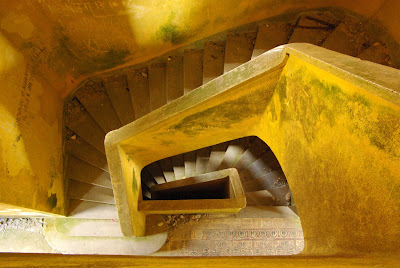 ...though most of the walls are covered up to eye level with grafitti (names carved by tourists into the plaster and moss) plus the occasional "renovation," possibly done by soldiers years ago:
...though most of the walls are covered up to eye level with grafitti (names carved by tourists into the plaster and moss) plus the occasional "renovation," possibly done by soldiers years ago:

The moss is fed by the fog that rolls in and out several times a day and swallows up the building, even during the dry season:

 We check out the church:
We check out the church:



...and the old post office:



At sunset, everyone heads back to the ranger station for dinner. Our guide, Net, talks to us a bit about the plans for Bokor Hill Station and about life in general. High school isn't free in Cambodia and he had to drop out of school for years to fish with his dad in their village. Now he's in Kampot and takes Chinese and English lessons, guiding tourists whenever there's work. "Not a lot of normal people can study," he says of university and college. "Only rich people. And also in Cambodia it is hard to loan the money from the bank. If you don't have land or job I think they don't allow us to loan money from the bank."
He tells us that Sokimex is planning to develop Bokor Hill Station into a swanky tourist area again, and that fixing the road and making it a paved 2-lane road is the first step in their plan. "Right now it looks quiet but in 2 years I think it is not." He shows us a 2009 calendar that shows Sokimex's plans. We take pictures of the drawings - currently, the area looks like this (close up shot of casino on the hill plus the ranger station below):

Over the next 18 years, they plan to develop it to look like this :
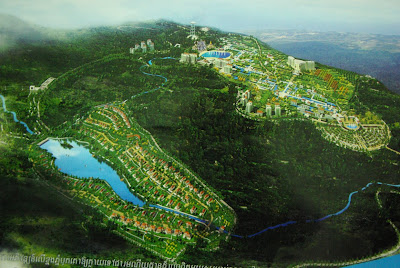 The lake at the top will have some tourist sites. (Check out the fake volcano in the middle, complete with flames shooting out the top):
The lake at the top will have some tourist sites. (Check out the fake volcano in the middle, complete with flames shooting out the top):
 A cottage community will be built up around the artifical lake they plan to build on the top:
A cottage community will be built up around the artifical lake they plan to build on the top:

We wonder what will happen to all of the moody old abandoned buildings, which are currently the big draw for tourists. He thinks they'll be restored. "For Cambodia, I think it's for the best. But for you I don't think it's the best." He's right - the development will steal a lot of the place's charm for a certain kind of tourist. (The project is also not in the best interests of the national park it sits in.)
On February 18th there's supposed to be an inauguration for the project, at which point it may become even more difficult to visit the Bokor Hill Station area. Our group may be one of the last groups of tourists to enjoy the Bokor Hill Station this way. We enjoy the silence - we're the only tourists up top tonight and the road construction workers have finally wrapped up their workday.
After dinner, we sit around the table and visit. Emma from the UK has just started a two-year trip around Asia and Australia. Florent and Joanna are in from France for a few weeks. Pierre gets a chance to talk some more with Peter. Peter and Nicky, the Australian contingent of our group, are on a working vacation in Cambodia photographing the sites. We covet Peter's medium format digital camera (= HUGE files plus a hand grip as comfy as a mitten) and he generously shares a few photography tips with us.
One of the biggest lessons we take away from our conversation with Peter is that, when it comes to lighting, it's hard to go wrong at sunrise. Our group, as a whole, decides to get up before dawn with him and explore the casino. At 5:30am, we all start to suit up and straggle up the hill.

The morning starts out clear, and the morning light makes all the colours of the moss and grasses much warmer:


The fog rolls in shortly afterwards and swallows up the building:

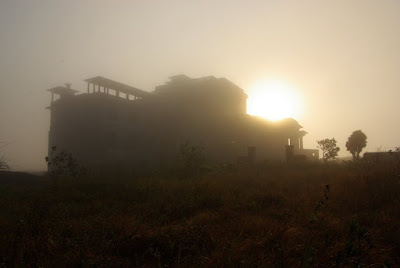

The fog makes it hard to see very far...

...so we head inside to take some shots indoors. The fog blocks the view of anything beyond a few feet from the building:
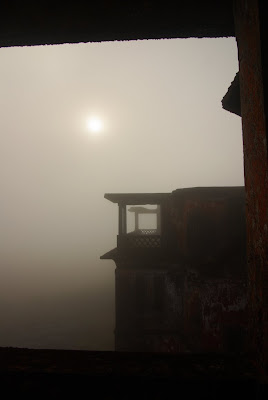



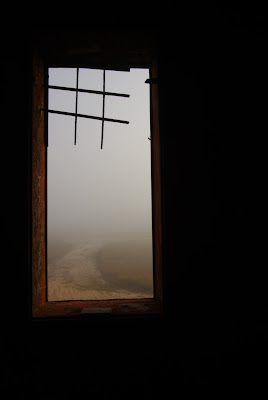
The mist pushes in through the empty windows and wanders through to the other side.

We catch a few final photographs...


...before heading down to meet up with Net and hike down the mountain.
The route down involves another trip in the flatbed, longer this time since we're taking another route down. This time, five of us follow Peter's lead and stand up near the cab, bracing ourselves with a metal bar and keeping our knees loose to ride with the bumps. Joanna and Emma brave things out seated on a tire. Down the road, the driver picks up an elderly monk and two young boys and they join us in the back. They take the bumpy road in stride, and laugh at us laughing at them and how well they handle the jolts.
The walk down is a few hours shorter and mostly uneventful. On one steep bit towards the end of the trail, Pierre slips on a rock while jumping downwards and does a weird slide/tumble combo. He lands in a cloud of dust in an inverted pushup handstand manoeuver - his feet are on the trail, one hand is holding a tree trunk and the other is gripping a rock. He's fine, just dusty and grateful for his good reflexes (though his neck, which was already sore for some unknown reason, remains sore for the next few weeks.) He brushes himself off and keeps hiking.
At the next water break, the French couple, who were right behind Pierre when he fell, ask him if he's ok and say it looked pretty impressive from their angle.
"Dix!" I say, and hold up an imaginary score card.
Joanna smiles, then makes thoughtful face and a moues her lips. "Mmm... Neuf point huit."
In town, the group wraps things up with fruit shakes at an open air restaurant. Peter shows us the photos he's gotten so far on the trip before they head off to catch the sunset in the next town. (The photographs are gorgeous - you can see them here in the Cambodia section of his site, peterbellingham.com).
Pierre and I are exhausted and hungry. The food included in the cost of our hike was good but not nearly plentiful enough to make up for the calories we burnt up during the hike. We feel like we've been at fat camp. We celebrate our successful trip to Bokor (didn't suck!) with well-deserved showers, a field trip to the bookstore and an early dinner.
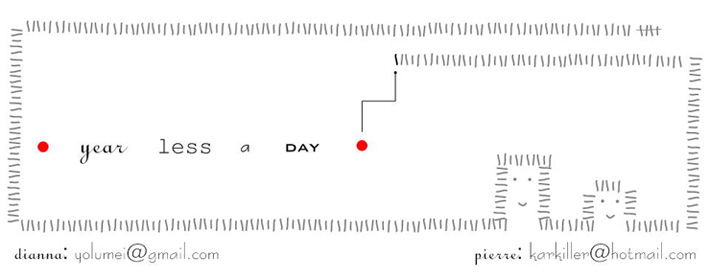





 ...museums and parks.
...museums and parks. 
 We drive past the royal palace...
We drive past the royal palace... 
 ..and the bicycles...
..and the bicycles... ...and the pedicabs...
...and the pedicabs...



 ...to check out the old French lighthouse across the river from our hotel:
...to check out the old French lighthouse across the river from our hotel:



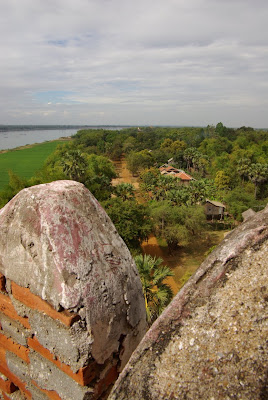















 ...though most of the walls are covered up to eye level with grafitti (names carved by tourists into the plaster and moss) plus the occasional "renovation," possibly done by soldiers years ago:
...though most of the walls are covered up to eye level with grafitti (names carved by tourists into the plaster and moss) plus the occasional "renovation," possibly done by soldiers years ago:









 The lake at the top will have some tourist sites. (Check out the fake volcano in the middle, complete with flames shooting out the top):
The lake at the top will have some tourist sites. (Check out the fake volcano in the middle, complete with flames shooting out the top):















